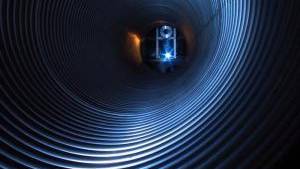Holographic Universe: Discovery Could Herald New Era In Fundamental Physics
Source: sciencedaily.com

Cardiff University researchers, who are part of a British-German team searching the depths of space to study gravitational waves, may have stumbled on one of the most important discoveries in physics, according to an American physicist.
Craig Hogan, a physicist at Fermilab Centre for Particle Astrophysics in Illinois is convinced that he has found proof in the data of the gravitational wave detector GEO600 of a holographic Universe – and that his ideas could explain mysterious noise in the detector data that has not been explained so far.
The British-German team behind the GEO600, which includes scientists from the School of Physics and Astronomy's Gravitational Physics Group, will now carry out new experiments in the coming months to yield more evidence about Craig Hogan's assumptions. If proved correct, it could help in the quest to bring together quantum mechanics and Einstein's theory of gravity.
In order to test the theory of holographic noise, the frequency of GEO600´s maximum sensitivity will be shifted towards ever higher frequencies. The frequency of maximum sensitivity is the tone that the detector can hear best. It is normally adjusted to offer the best chance for hearing exploding stars or merging black holes.
Even if it turns out that the mysterious noise is the same at high frequencies as at the lower ones, this will not constitute proof for Hogan's hypothesis. It would, however, provide a strong motivation for further study. The sensitivity of GEO600 will then be significantly improved by using 'squeezed vacuum' and by the installation of a mode filter in a new vacuum chamber. The technology of 'squeezed vacuum' was particularly refined in Hannover and would be used in a gravitational wave detector for the first time.
Professor Jim Hough of Glasgow University, one of the pioneer developers of gravitational wave detectors, says: 'Craig Hogan made a very interesting prediction. It may be the first of a number of unexpected possibilities to be investigated as gravitational wave detectors become more sensitive.'
Professor Bernard Schutz, Professor at the School of Physics and Astronomy, member of the Gravitational Physics Group at the School, and recently elected as an Honorary Fellow of the Royal Astronomical Society said: "It would be truly remarkable if GEO600 is sensitive to the quantum nature of space and time. The only way to confirm that would be to carry out controlled experiments, the results of which can be solely attributed to holographic noise. Such an experiment would herald a new era in fundamental physics".
Professor Dr. Karsten Danzmann, director of the Hannover Albert-Einstein-Institute, said: "We are very eager to find out what we can learn about the possible holographic noise over the course of the coming year. GEO600 is the only experiment in the world able to test this controversial theory at this time. Unlike the other large laser interferometers, GEO600 reacts particularly sensitively to lateral movement of the beam splitter because it is constructed using the principle of signal recycling. Normally this is inconvenient, but we need the signal recycling to compensate for the shorter arm lengths compared to other detectors. The holographic noise, however, produces exactly such a lateral signal and so the disadvantage becomes an advantage in this case. You could say that this has placed us in the very centre of a tornado in fundamental research!
Searching for the graininess of space
The smallest possible fraction of distance is called the 'Planck length" by physicists. Its value is 1.6 x 10-35 m – this is impossible to measure by itself. The established physical theories cease to function at this scale. GEO600 scientists are testing a theory by US physicist Craig Hogan, who is convinced he can hear the noise of space quanta in the data of the gravitational wave detector GEO600. Hogan suggests that the mirrors in an interferometer wander relative to one another in very rapid steps of the tiny Planck amount, that accumulate during the time of a measurement into something as large as a gravitational wave would produce. Hogan and the GEO600 scientists are following up the question whether a certain 'noise signal' in the data recorded by the detector can be traced back to the graininess of space and time.
GEO600
Because of its innovative and reliable technology, GEO 600 has gained an excellent worldwide reputation and is considered a think-tank for international gravitational wave observation. It was here that the most modern lasers in the world were developed which are being used in all the gravitational wave observatories in the world today. Researchers at GEO600 are taking technology a step further with 'squeezed vacuum'. This technology is designated for use in the third generation of gravitational wave detectors.
GEO600 is a joint project of scientists of the Max Planck Institute for Gravitational Physics (Albert Einstein Institute, or AEI), Leibniz Universität Hannover, Cardiff University, the University of Glasgow and the University of Birmingham. It is funded jointly by the Max Planck Society in Germany and the Science and Technology Facilities Council in UK.
Source: Holographic Universe: Discovery Could Herald New Era In undamental Physics
For more on the GEO600 experiment, tune into our radio program with Jim Elvidge
Micheal Talbot - The Holographic Universe






















